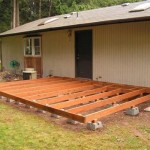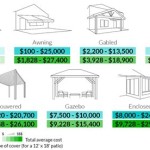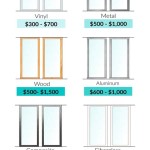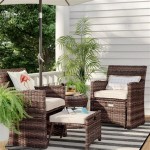Designing the Perfect Deck and Patio: A Comprehensive Guide
Decks and patios serve as extensions of the home, transforming outdoor spaces into functional areas for relaxation, entertainment, and recreation. Well-designed decks and patios enhance property value and contribute to a more enjoyable lifestyle. The design process involves careful consideration of various factors, including site conditions, intended use, materials, and budget. This article provides a comprehensive guide to designing stunning and functional decks and patios.
Understanding Site Conditions and Their Influence
Before embarking on any deck or patio project, a thorough assessment of the site is crucial. This assessment should encompass several key aspects that directly influence the design and construction phases. Accurate information gathered during this initial step mitigates potential problems and ensures a successful outcome.
Firstly, soil composition plays a vital role. The type of soil present – whether it’s clay, sand, or loam – impacts drainage and the stability of the foundation. Clay soils, for instance, tend to retain water, potentially leading to issues with frost heave and structural damage over time. Sandy soils, on the other hand, drain quickly but may not provide adequate support for heavy structures. A soil test conducted by a professional will provide detailed information about the soil's properties, allowing for appropriate foundation designs and drainage solutions.
Secondly, existing landscaping elements, such as trees, shrubs, and utility lines, require careful consideration. Trees can provide shade and aesthetic appeal, but their root systems can interfere with the deck or patio’s foundation. Similarly, the presence of underground utility lines necessitates careful planning to avoid damage during excavation. Locating and mapping these elements before construction begins prevents costly repairs and ensures safety.
Thirdly, drainage patterns are paramount. Proper drainage prevents water from accumulating around the deck or patio, which can lead to damage, mold growth, and safety hazards. Identifying the natural slope of the land and implementing appropriate drainage solutions, such as French drains or grading, is essential. Inadequate drainage can result in standing water, which attracts mosquitoes and creates an unpleasant outdoor environment.
Finally, sunlight exposure and wind patterns should be analyzed. The amount of sunlight the area receives determines the types of plants that can thrive in the landscape and the need for shade structures, such as pergolas or awnings. Wind patterns influence the placement of furniture and the need for windbreaks. Understanding these factors allows for the creation of a comfortable and usable outdoor space throughout the year.
Selecting the Right Materials for Durability and Aesthetics
The choice of materials significantly impacts the longevity, appearance, and maintenance requirements of a deck or patio. A wide array of options exists, each with its own advantages and disadvantages. Selecting materials that align with the design aesthetic, budget constraints, and performance expectations is vital.
For decking, wood remains a popular choice due to its natural beauty and warmth. Pressure-treated lumber is a cost-effective option, but it requires regular maintenance to prevent rot and decay. Cedar and redwood are naturally resistant to insects and moisture, making them more durable but also more expensive. Composite decking, made from recycled plastic and wood fibers, offers excellent resistance to weathering, insects, and rot. It requires minimal maintenance but typically comes at a higher initial cost. Exotic hardwoods, such as Ipe and Tigerwood, provide exceptional durability and aesthetic appeal, but they are the most expensive option.
Patio materials also offer diverse choices. Concrete is a versatile and durable option that can be stained, stamped, or textured to mimic the look of natural stone. Pavers, made from concrete, brick, or natural stone, offer a wide range of colors, shapes, and patterns. Natural stone, such as flagstone, bluestone, and slate, provides a unique and timeless look. While aesthetically pleasing, natural stone can be more expensive and require more maintenance than other options. Gravel is an affordable and permeable option that can be used for pathways or small patios. However, it requires regular raking and may not be suitable for areas with heavy foot traffic.
In addition to the primary decking or patio material, consider the materials for railings, steps, and other structural elements. Railings can be made from wood, metal, glass, or composite materials. Steps can be constructed from the same material as the deck or patio or from a contrasting material for visual interest. Choosing high-quality materials that are appropriate for the climate and intended use will ensure the longevity and beauty of the outdoor space.
Also consider using recycled or sustainable materials whenever possible. Using reclaimed wood, recycled composite decking, or permeable pavers promotes environmentally responsible construction practices.
Designing for Functionality and Intended Use
A successful deck or patio design must align with the intended use of the space. Whether the area is intended for dining, lounging, entertaining, or a combination of activities, the design should accommodate these functions comfortably and efficiently. Thoughtful planning ensures that the space meets the needs of the users and enhances their outdoor experience.
For dining areas, consider the size of the dining table and the number of people it will accommodate. Ensure that there is adequate space around the table for comfortable movement. Incorporate features such as built-in benches or outdoor kitchen areas to enhance the dining experience. Position the dining area in a location that offers shade during peak sun hours.
Lounging areas should be designed for relaxation and comfort. Incorporate comfortable seating, such as lounge chairs, sofas, or hammocks. Consider adding a fire pit or outdoor fireplace to create a cozy and inviting atmosphere. Provide shade from the sun with umbrellas, pergolas, or awnings. Strategically placed landscaping can also provide privacy and create a sense of seclusion.
Entertaining spaces should be designed to accommodate large groups of people. Incorporate features such as outdoor bars, grilling stations, and ample seating. Consider adding an outdoor sound system and lighting to create a festive atmosphere. Ensure that there is adequate space for movement and mingling. Designate specific areas for different activities, such as dining, dancing, or conversation.
In addition to these primary functions, consider incorporating other features that enhance the usability of the space. Storage areas can be used to store outdoor furniture cushions, gardening tools, or sporting equipment. Outdoor lighting can extend the usability of the space into the evening hours. Water features, such as fountains or ponds, can add visual interest and create a relaxing ambiance. The ultimate goal is to create an outdoor space that is both functional and aesthetically pleasing, meeting the specific needs and desires of the users.
Consider the flow between the indoor and outdoor spaces. A smooth transition between the home's interior and the deck or patio enhances the overall functionality of the space. Sliding glass doors, French doors, or large windows can create a seamless connection between the two areas. Maintaining a consistent design aesthetic between the interior and exterior spaces will create a cohesive and harmonious living environment.
Accessibility is another crucial factor. Ensure that the deck or patio is easily accessible from the house and the surrounding landscape. Consider incorporating ramps or gradual slopes to accommodate individuals with mobility issues. Adequate lighting and clear pathways can enhance safety and accessibility, particularly during the evening hours.
Finally, consider the privacy of the space. If the deck or patio is located in a densely populated area, incorporate features such as privacy screens, hedges, or fences to create a sense of seclusion. Strategically placed landscaping can also provide privacy and block unwanted views.
Lighting Strategies for Ambiance and Safety
Outdoor lighting is crucial for both ambiance and safety. Well-planned lighting extends the usability of the deck or patio into the evening hours and enhances the overall aesthetic appeal of the space. A variety of lighting options are available, each with its own advantages and disadvantages. Selecting the right lighting fixtures and placement techniques ensures that the space is both functional and visually appealing.
Ambient lighting provides general illumination and creates a welcoming atmosphere. String lights, lanterns, and post lights are popular choices for ambient lighting. These fixtures can be placed along railings, under eaves, or around the perimeter of the deck or patio. Dimmable lights allow for adjusting the brightness to create different moods.
Task lighting provides focused illumination for specific activities, such as grilling, dining, or reading. Under-cabinet lighting, spotlights, and adjustable fixtures are ideal for task lighting. These fixtures can be positioned to illuminate work surfaces, dining tables, or reading nooks.
Accent lighting highlights specific features, such as plants, architectural details, or water features. Spotlights, uplights, and path lights are commonly used for accent lighting. These fixtures can be strategically placed to draw attention to interesting elements and create visual interest.
Safety lighting is essential for preventing accidents and ensuring safe passage. Step lights, path lights, and motion-sensor lights are important safety features. Step lights illuminate the edges of steps and pathways, while path lights guide visitors along walkways. Motion-sensor lights provide added security and deter intruders.
In addition to the type of lighting, consider the color temperature. Warm white light (2700K-3000K) creates a cozy and inviting atmosphere, while cool white light (4000K-5000K) provides brighter and more focused illumination. Choose a color temperature that complements the design aesthetic and intended use of the space.
Energy efficiency is another important consideration. LED lights are a popular choice due to their long lifespan and low energy consumption. Solar-powered lights are also an option, but they may not provide as much illumination as electric lights.
The placement of lighting fixtures is just as important as the type of lighting. Avoid placing lights where they will cause glare or shine directly into people's eyes. Consider using shielding or baffles to direct the light downward and prevent light pollution. A well-planned lighting design will enhance the beauty and functionality of the deck or patio, making it a safe and enjoyable space to spend time in the evening.
Consider incorporating smart lighting systems that can be controlled remotely. These systems allow for adjusting the brightness, color, and scheduling of the lights from a smartphone or tablet. Smart lighting can also be integrated with other smart home devices, such as security systems and voice assistants.
By carefully considering these factors, homeowners can design decks and patios that are not only beautiful but also functional, safe, and enjoyable for years to come.

Outdoor Deck And Patio Ideas Aspen Designs

34 Comfy Backyard Patio Deck Designs Ideas For Relaxing Design

15 Gorgeous Deck And Patio Ideas You Can Diy Family Handyman

Achieving The Ideal Deck Or Patio Design Outdoor Living

Outdoor Deck Design Ideas 5 Backyard Designs For Your Space

Professional Landscape Design Groff

Why Build A Patio Under Your Deck Disabatino Landscaping

How To Plan A Deck Tips For Design Layout Timbertech

Deck Ideas 40 Ways To Design A Great Backyard Or Patio Sunset

75 Backyard Deck Ideas You Ll Love November 2024 Houzz








